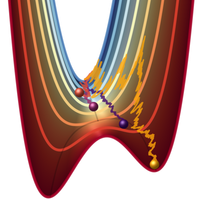Tracking the Distance to Criticality in Systems with Unknown Noise
IF 11.6
1区 物理与天体物理
Q1 PHYSICS, MULTIDISCIPLINARY
引用次数: 0
Abstract
Many real-world systems undergo abrupt changes in dynamics as they move across critical points, often with dramatic and irreversible consequences. Much existing theory on identifying the time-series signatures of nearby critical points, such as increased signal variance and slower timescales, is derived from analytically tractable systems, typically considering the case of fixed, low-amplitude noise. However, real-world systems are often corrupted by unknown levels of noise that can distort these temporal signatures. Here we aim to develop noise-robust indicators of the distance to criticality (DTC) for systems affected by dynamical noise in two cases: when the noise amplitude is either fixed or is unknown and variable across recordings. We present a highly comparative approach to this problem that compares the ability of over 7000 candidate time-series features to track the DTC in the vicinity of a supercritical Hopf bifurcation. Our method recapitulates existing theory in the fixed-noise case, highlighting conventional time-series features that accurately track the DTC. But in the variable-noise setting, where these conventional indicators perform poorly, we highlight new types of high-performing time-series features and show that their success is accomplished by capturing the shape of the invariant density (which depends on both the DTC and the noise amplitude) relative to the spread of fast fluctuations (which depends on the noise amplitude). We introduce a new high-performing time-series statistic, the rescaled autodensity (RAD), that combines these two algorithmic components. We then use RAD to provide new evidence that brain regions higher in the visual hierarchy are positioned closer to criticality, supporting existing hypotheses about patterns of brain organization that are not detected using conventional metrics of the DTC. Our results demonstrate how large-scale algorithmic comparison can yield theoretical insights that can motivate new theory and interpretable algorithms for solving important real-world problems.

跟踪未知噪声系统中的临界距离
现实世界中的许多系统在跨越临界点时都会发生突然的动态变化,往往会造成不可逆转的严重后果。关于识别临界点附近的时间序列特征(如信号方差增大和时间尺度变慢),现有的许多理论都是从可分析的系统中推导出来的,通常考虑的是固定、低振幅噪声的情况。然而,现实世界中的系统往往会受到未知噪声水平的干扰,从而扭曲这些时间特征。在这里,我们的目标是为受动态噪声影响的系统开发噪声稳健的临界距离(DTC)指标,包括两种情况:噪声振幅固定或未知且在不同记录中可变。我们针对这一问题提出了一种高度比较性的方法,比较 7000 多个候选时间序列特征在超临界霍普夫分岔附近跟踪 DTC 的能力。我们的方法重现了固定噪声情况下的现有理论,突出了能准确跟踪 DTC 的常规时间序列特征。但在可变噪声环境下,这些传统指标表现不佳,我们突出强调了新型高性能时间序列特征,并表明它们的成功是通过捕捉不变密度(取决于 DTC 和噪声振幅)相对于快速波动扩散(取决于噪声振幅)的形状实现的。我们引入了一种新的高性能时间序列统计量--重标定自密度(RAD),它结合了这两种算法成分。然后,我们利用 RAD 提供了新的证据,证明视觉层次结构中较高的脑区位置更接近临界点,从而支持了现有的关于大脑组织模式的假设,而这些模式是 DTC 的传统指标所无法检测到的。我们的研究结果展示了大规模算法比较如何产生理论见解,从而激发新的理论和可解释的算法,以解决现实世界中的重要问题。
本文章由计算机程序翻译,如有差异,请以英文原文为准。
求助全文
约1分钟内获得全文
求助全文
来源期刊

Physical Review X
PHYSICS, MULTIDISCIPLINARY-
CiteScore
24.60
自引率
1.60%
发文量
197
审稿时长
3 months
期刊介绍:
Physical Review X (PRX) stands as an exclusively online, fully open-access journal, emphasizing innovation, quality, and enduring impact in the scientific content it disseminates. Devoted to showcasing a curated selection of papers from pure, applied, and interdisciplinary physics, PRX aims to feature work with the potential to shape current and future research while leaving a lasting and profound impact in their respective fields. Encompassing the entire spectrum of physics subject areas, PRX places a special focus on groundbreaking interdisciplinary research with broad-reaching influence.
 求助内容:
求助内容: 应助结果提醒方式:
应助结果提醒方式:


